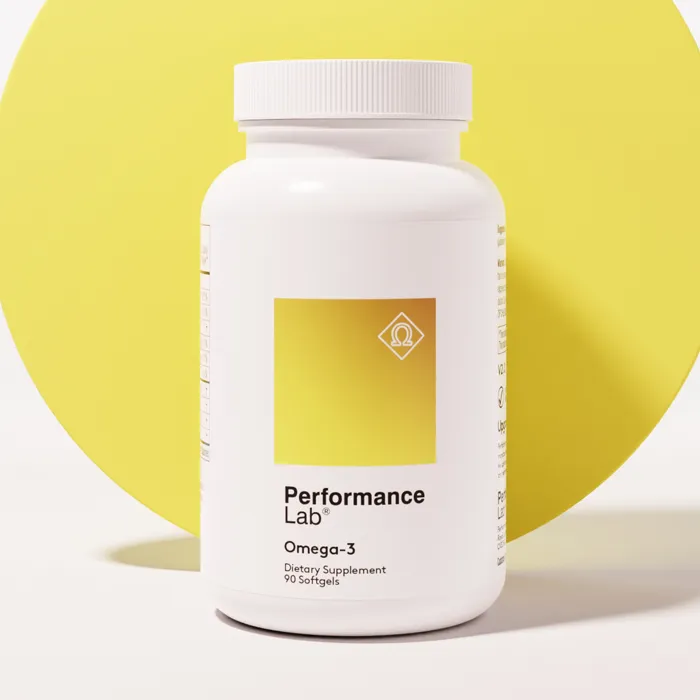Omega-3 supplements are a hot topic in the nutrition world.
They’re involved in everything from reducing inflammation and improving athletic recovery, to enhancing cognitive function and preventing chronic disease development.
And one of the most talked-about omega-3 supplements is fish oils—but it’s not the only one.
There are some great sources of plant-based omega-3s available that both meat-eaters and vegans alike can enjoy that are rich in other nutrients, as well.
Key Takeaways
- Omega 3 fatty acids support heart health, brain function, inflammation balance, and long term wellbeing.
- Plant foods like flaxseeds, chia seeds, walnuts, algae, and certain oils provide vegetarian sources of omega 3s.
- Most plant sources supply ALA, which the body must convert into EPA and DHA, and this conversion is limited for many people.
- Combining a plant rich diet with an algae based omega 3 supplement is an effective way for vegetarians and vegans to reach optimal EPA and DHA levels.

What Is An Omega-3?

Omega-3s are a group of essential fatty acids that fall into the broad category of polyunsaturated fatty acids, along with its partner in crime, omega-6s.
They are fats that cannot be produced within the body and therefore must be obtained through diet or a supplement.
To be specific, there are three types of omega-3 fatty acids. These are: eicosapentaenoic acid (EPA), docosahexaenoic acid (DHA), and alpha-linolenic acid (ALA).
The first two are commonly sourced from fish tissue, while the third is sourced from plants.
The Problem With Conventional Omega-3 (Fish Oil) Supplements
We’ve mentioned it before, but there’s quite a substantial body of research supporting the fact that fish oils aren’t all they’ve cracked up to be.
Here are the main reasons why 1:
1. Contamination: Chemical contaminants are a huge massive issue with fish oils during production because of things like heavy metals, pesticides, and antibiotics found in water sources and feed. These make their way into the fish’s tissue and into your body.
Why You Need Omega-3s
Getting in enough omega-3s daily, specifically EPA and DHA, is critical to your overall health and well-being. They’re involved in:
- Cell membrane structure
- Nervous system function
- Immunity
- Regulating inflammation
- Brain health
- Pregnancy
- Heart health
The role of ALA
When people talk about omega-3s, they’re not generally referring to ALA, they’re talking about EPA and DHA. But even so, ALA still plays a role in the body.
The main primary role of ALA is as a source of energy. To be used for something other than fuel, it has to be converted to EPA and DHA, which is not a very efficient process (more on this below).
But without conversion, ALA is used as an energy source just as any other fat would be, or stored.
Some rodent studies have also suggested that ALA could be beneficial for improving CVD risk markers, as it helps to lower LDL 2.
Whether this translates to humans, however, is unknown.
The Best 7 Plant-Based Sources of Omega-3s
1. Chia Seeds
Of all the known food sources, chia seeds are the powerhouse of essential fatty acids, with about 65% coming from omega-3 and 19% coming from omega-6 3. Per ounce, chia seeds contain over 5.0g of omega-3s 5.
2. Hemp Seeds
Hemp seeds and hemp seed oil are a potent source of both omega-3 (ALA) and omega-6 (LA) fatty acids in an approximate 3:1 LA to ALA ratio.
Studies suggest that hemp is so beneficial because of its ratio of LA:ALA; most oils do not contain the optimal ratios of omega-6 to omega-3 fats, which tend to promote the accumulation of metabolic intermediates that hinder fatty acid metabolism.
Hemp, on the other hand, is appropriately balanced and therefore doesn’t promote an excess buildup of intermediates 4.
Per tablespoon, hemp seeds contain about 2.6g of ALA 5.
3. Walnuts
On an ounce per ounce basis, walnuts contain more omega-3s than salmon, however, that is ALA.
Per cup, walnuts contain around 3.4g of ALA 5. But it’s not just omega-3s that make walnuts beneficial. They’re also a concentrated source of copper and manganese.
4. Flaxseeds
Flax is known as a great source of fiber, but it’s also an excellent source of omega-3 fatty acids.
Pure flaxseed oil is your best bet for ALA, with approximately 7.3g of ALA per tablespoon 5.
While flaxseeds are another great option, they often pass through the digestive tract undigested unless consumed ground, and also must be fresh to avoid oxidation of the delicate oils.
5. Edamame
Edamame might not seem like it’s rich in omega-3s, but per cup, it contains about 0.55g of ALA 5.
Not to mention, it’s also a great source of complete protein (contains all nine essential amino acids), fiber, folate, and vitamin K.
6. Purslane
Purslane is probably something you’ve never heard of before, but is a small edible succulent that grows around the world due to its ability to grow in poor soil conditions.
Commonly thought of as a weed, it’s surprisingly high in omega-3s—both ALA and trace amounts of EPA.
It contains up to five times more omega-3 than spinach, with approximately 4mg per gram of fresh weight.
And interestingly enough, it also contains small amounts of EPA—1mg per 100 grams of fresh purslane 6.
It’s also an excellent source of alpha-tocopherol (vitamin E), ascorbic acid (vitamin C), beta-carotene, and glutathione (antioxidant) 7.
7. Algae Oil
Algae and other seaweeds are arguably one of the best sources of omega-3 fatty acids on a plant-based diet, and even if you eat meat; it provides a much more potent and sustainable source compared to fish oils.
While people always turn towards fish for EPA and DHA, fish don’t actually produce it—it accumulates in their tissues from their diet.
Algae, on the other hand, is a direct producer of both EPA and DHA. It is the only plant source that contains omega-3 fatty acids that need not undergo conversion to be utilized by the body.
One study found that people taking 600 mg daily of DHA from algae oil boosted blood levels the same amount as people taking an equal amount of DHA from fish oil, suggesting that the omega-3s in algae oil are just as effective as those from fish 8.
The Problem With Plant-based Omega-3 Supplements
One of the major significant concerns with plant-based omega-3 supplements not derived from algae is that they’re not overly effective if you’re taking them for EPA and DHA content.
That’s because in order for ALA to be utilized in the body for more than energy, it has to be converted to EPA and DHA, and this conversion process is not efficient.
It has a conversion rate of around 6% to EPA and 3.8% to DHA 9. See why now?
Because the conversion rate of ALA to EPA and DHA is so low, consuming lots of omega-3 rich foods is great for getting several other nutrients.
Still, it’s recommended to take an EPA/DHA supplement to ensure you’re getting adequate amounts of usable omega-3 (EPA and DHA).
Performance Lab Omega 3

Like we mentioned above, the conversion rate of ALA to EPA and DHA is minimal, which means that besides eating omega-3 rich foods, you’ll want to get an omega-3 supplement like Performance Lab Omega 3.
Performance Lab Omega 3 is the cleanest, safest vegan-friendly omega-3 supplement on the market.
It supplies high-potency EPA and DHA, without all the drawbacks of traditional fish oil supplements.
It’s also ultraclean, with no heavy metals, PCBs, or toxic contaminants; is environmentally friendly and sustainable, and completely traceable from start to finish.
What more could you want from a supplement?
References
- TC Adarme-Vega, DK Lim, M Timmins, F Vernen, Y Li, PM Schenk. Microalgal biofactories: a promising approach towards sustainable omega-3 fatty acid production. Microb Cell Fact. 2012; 11: 96.
- N Blondeau, RH Lipsky, M Bourourou, MW Duncan, PB Gorelick, AM Marini. Alpha-linolenic acid: an omega-3 fatty acid with neuroprotective properties-ready for use in the stroke clinic? Biomed Res Int. 2015 Feb.
- R Ullah, M Nadeem, A Khalique, et al. Nutritional and therapeutic perspectives of Chia (Salvia hispanica L.): a review. J Food Sci Technol. 2016; 53(4): 1750-1758.
- C Leizer, D Ribnicky, A Pouley, S Dushenkov, I Raskin. The composition of hemp seed oil and its potential as an important source of nutrition. Journal of nutraceuticals, functional & medical foods. 2005; 2(4): 35-53.
- https://ods.od.nih.gov/pubs/usdandb/ALA-Content.pdf
- MK Uddin, AS Juraimi, MS Hossain, MA Nahar, ME Ali, MM Rahman. Purslane weed (Portulaca oleracea): a prospective plant source of nutrition, omega-3 fatty acid, and antioxidant attributes. Scientific World Journal. 2014 Feb.
- AP Simopoulos, HA Norman, JE Gillaspy, JA Duke. Common purslane: a source of omega-3 fatty acids and antioxidants. J Am Coll Nutr. 1992 Aug; 11(4): 374-82.
- L Ryan, AM Symington. Algal-oil supplements are a viable alternative to fish-oil supplements in terms of docosahexaenoic acid (22:6n-3; DHA). Journal of functional foods. 2015; 19: 852-858.
- H Gerster. Can adults adequately convert alpha-linolenic acid (18:3n-3) to eicosapentaenoic acid (20:5n-3) and docosahexaenoic acid (22:6n-3)? Int J Vitam Nutr Res. 1998; 68(3): 159-73.
















